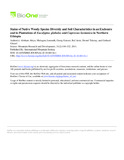Status of native woody species diversity and soil characteristics in an exclosure and in plantations of Eucalyptus globulus and Cupressus lusitanica in Northern Ethiopia
Date
2011-05Author
Abiyu, A.
Lemenih, M.
Gratzer, G.
Aerts, R.
Teketay, D.
Glatzel, G.
Publisher
BioOne, www.bioone.orgType
Published ArticleMetadata
Show full item recordAbstract
Exclusion of grazing animals and tree plantations are 2 methods that have been used for restoration of degraded lands in tropical semiarid areas. These 2 options can foster secondary forest succession by improving soil conditions, attracting seed-dispersal agents, and modifying microclimate for understory growth. We compared native woody plant diversity and soil chemical and physical attributes under exclosure and on Eucalyptus globulus (EGP) and Cupressus lusitanica (CLP) plantations. Vegetation data were collected by an inventory of stands with circular plots of 5.64 m radius, and soil samples were collected from the 4 corners and center of 20 × 20 m plots. As a result, 15 native woody plant species belonging to 13 families were recorded. Importance value index (IVI), Shannon-Wiener, Simpson's diversity, and species richness were higher in the exclosure, followed by EGP and CLP. Contents of soil organic carbon and total nitrogen showed significance difference and were highest in the exclosure, followed by CLP, EGP, and grazing land. Although the difference was not significant, an increasing trend was observed for cation exchange capacity and K+. Bulk density was highest on the grazing land, followed by EGP, CLP, and exclosure. Our results suggest that degraded land reclamation can be achieved with plantation of rapidly growing tree species as well as exclosure. However, native woody species diversity and improved soil attributes are better achieved with exclosure. Exclosures can be established interspersed strategically with single- or mixed-species plantations to facilitate restoration of native vegetation. However, it is important to conduct further research on the comparative advantage of enrichment planting of exclosures with preferred tree species or exclosures interspersed within blocks of plantation.
Collections
- Research articles (ORI) [270]

